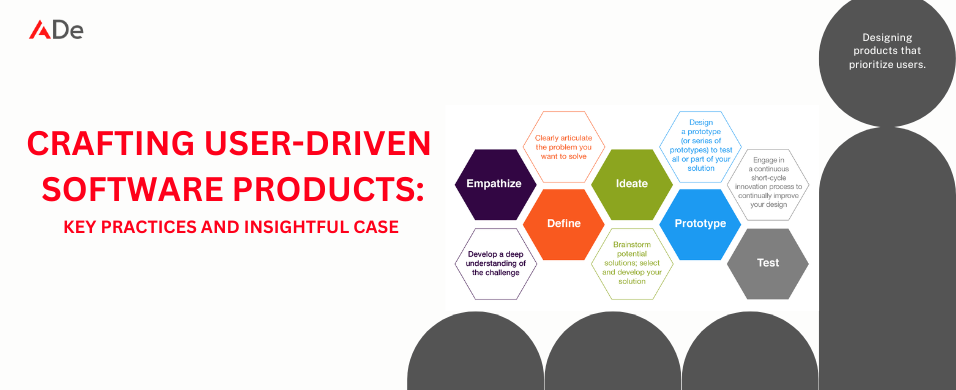In the ever-evolving world of software development, creating user-driven products is not just a trend; it’s a necessity. Users today demand more than just functional software; they want intuitive interfaces, seamless experiences, and tailored solutions. This blog explores the key practices of crafting user-driven software products, along with some insightful case studies spanning UI/UX design, e-commerce development, mobile app development, and web development.
Understanding the User-Centric Approach
Before diving into the case studies, it’s crucial to understand the essence of a user-centric approach. Creating user-driven software means placing the end-user at the core of the development process. It involves empathizing with their needs, preferences, and pain points.

- User Research: The journey starts with in-depth user research. Analyzing user behaviour, conducting surveys, and gathering feedback are all essential in comprehending user requirements.
- Define: Create user personas, set clear project objectives, and establish detailed requirements to guide the development process effectively.
- UI/UX Design: User Interface (UI) and User Experience (UX) design play a pivotal role in crafting software that’s intuitive and enjoyable to use. This includes creating an appealing design, intuitive navigation, and smooth interactions.
- Evaluate: Conduct usability and user testing to gather feedback, identify issues, and make data-driven decisions for improvement.
- Iteration: A user-centric approach is iterative. It involves continuous testing, feedback collection, and making improvements based on user input.
Now, let’s delve into some case studies that highlight the importance of these principles.
Case Study 1: UI/UX Design in E-commerce – Amazon
When we think of e-commerce giants, Amazon invariably comes to mind. They have set the gold standard for UI/UX design in this industry. Their success is not only due to their vast product range but also their user-friendly platform.
Key Practices in UI/UX Design
- Simplified Navigation: Amazon’s website and app offer a straightforward menu and search bar, allowing users to quickly find what they need.
- Personalization: Amazon uses algorithms to suggest products based on users’ browsing and purchasing history, enhancing the user experience.
- User Reviews: Customer reviews play a significant role in user decision-making, adding a layer of social proof.
- Responsive Design: Amazon’s platform is optimized for various devices, ensuring a seamless experience on desktop and mobile.
Case Study 2: E-commerce Development – Shopify
Shopify has revolutionized e-commerce development with its user-friendly platform that allows businesses to create their online stores effortlessly.
Key Practices in E-commerce Development
- Customization: Shopify offers an array of customizable templates, enabling businesses to create unique online storefronts that align with their brand identity.
- Easy Payment Integration: Integrating payment gateways is simple, making it easy for customers to complete their purchases.Inventory Management: The platform provides robust tools for inventory management, allowing businesses to keep track of their products effectively.
- Scalability: Shopify can grow with your business, from small startups to large enterprises.
Case Study 3: Mobile App Development – Uber
Uber disrupted the traditional taxi industry with its user-centric mobile app. It transformed the way people commute and introduced the concept of on-demand services.
Key Practices in Mobile App Development
- User-Friendly Interface: The Uber app is exceptionally user-friendly, making it easy for users to book rides, track drivers, and make payments.
- Real-Time Tracking: The real-time location tracking feature enhances user safety and convenience.
- In-App Payments: The seamless in-app payment system removes the hassle of cash transactions, increasing convenience.
- User Ratings: Driver and passenger ratings create accountability and trust within the app.
Case Study 4: Web Development – WordPress
WordPress is a powerful and user-driven web development platform. It has empowered millions to create websites without extensive technical knowledge.
Key Practices in Web Development
- User-Friendly Content Management: WordPress offers a straightforward content management system, allowing users to update their websites with ease.
- Vast Plugin Ecosystem: A wide array of plugins allows users to add functionality to their websites without coding.
- Themes and Customization: Users can choose from a variety of themes and customize their websites to reflect their unique brand.
- Community Support: A strong community of developers and users provides support and resources for those new to web development.
Conclusion
Crafting user-driven software products is not just a choice; it’s a necessity in today’s competitive market. Successful companies like Amazon, Shopify, Uber, and WordPress have shown us that by understanding the user, focusing on UI/UX design, and applying user-centric development practices, remarkable software products can be built.
The key takeaway from these case studies is that listening to your users, designing for their needs, and continually iterating based on their feedback can lead to exceptional software products that not only meet user expectations but also exceed them. Whether you’re in e-commerce, mobile app development, or web development, the user must remain at the forefront of your product development journey. User-driven software isn’t just a trend; it’s the future of software development, and the companies that embrace it will undoubtedly thrive in the ever-evolving digital landscape.



